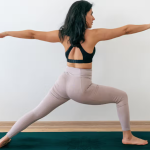Having just graduated from the YogaLondon 200-hour course in February this year, I still have a very fresh memory of the work I had to do, not only during class hours, but also the homework and study outside of the course. Many people embarking on yoga courses have full-time jobs, so it’s important to know what the teacher training workload is outside of the weekends that you’re in class with YogaLondon.
Cultivating Your Practice
Being a yogi, you may already have a strong practice, but when you sign up for a teacher training course, that becomes even stronger. Our course leader was quick to inform us that we were expected to practice yoga six days a week. As I work from home I possibly found this easier than some, and even though it might be tough on your body at first, it was actually a very welcome change to my weekly routine. Sure, I had to sacrifice other forms of fitness I enjoy, but on days where I’d normally be in the gym I just opted for a Power Yoga class. In the first few weekends you’ll learn a lot about alignment and technique, so if you’re anything like me you’ll want to hop on your mat as soon as possible to work on what you’ve learned.
Other aspects of physical practice outside of your course hours will be finding a bit of time to teach friends and family. Obviously you’ll want to wait until you’ve completed a bit of teaching practice on the course, but once you have it’s really great to get as much teaching experience as possible — I dragged my mum out of bed at 7am to teach her a restorative flow on numerous occasions!
See Also: How Exactly Do Yoga and Pilates Differ?
Putting Pen to Paper
Over the duration of the course we had to complete three external yoga class observations. The course leader goes through this in detail in weekend one or two, and you’ll be given hand-in deadlines for each one. Ideally you’ll observe three different classes, with a different teacher each time, noting down what and how they taught, modifications, students reactions to the class and so on. I wrote my first observation in so much detail that it took me about four hours to write up, but you soon get used to taking notes and the way to present it for your tutor, so my final two didn’t take as long.
In terms of theory there’s a lot to take in and even though it seems very daunting at first — my brain felt totally frazzled after the first weekend — it does get easier and you find yourself slowly but surely picking up on things you’ve been taught.
I’d hugely recommend reading over your notes after each weekend, so that it doesn’t seem like too big of a task when your exams are nearing. I’m very aware that this is easier said than done, but I used my travel time on the train to read over everything. At the start of the course you’ll be given posture note cards, so I’d recommend learning the pose names in both English and Sanskrit and things like the eight limbs of yoga quite early on. I usually got my partner to test me on them every Monday night, and that way I felt confident using those concepts in my teaching practice and assessment.
Being Aware of the Teacher Training Workload
This all may already sound like a lot of work, but you’re working on your passion, so for me it just felt like part of the journey and I made time for it. The tutors at YogaLondon are all extremely knowledgeable so most weekends you’ll walk out with a little post-it note full of websites, books, documentaries and workshops to check out. These aren’t compulsory at all, but it’s great to explore as many things recommended to you as possible to broaden your understanding of yoga.
The beauty of YogaLondon is that they want each student to find their own teaching path. The teachers aren’t there to mold you, they are there to help guide you, so any further reading, watching or learning you do can only benefit you.













